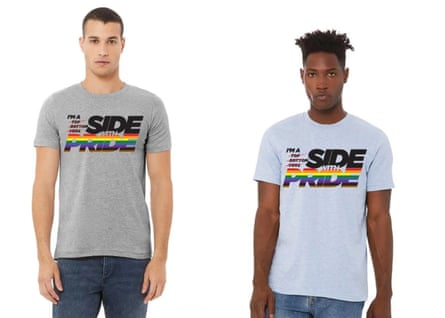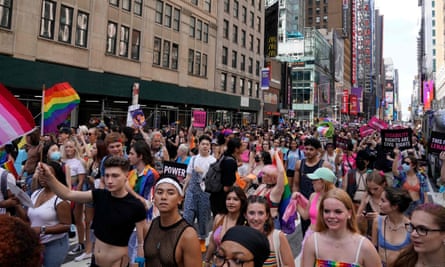Every month, nearly 11 million gay men around the world go on the Grindr app to look for sex with other men. Once there, they can scroll through an endless stream of guys, from handsome to homely, bear to twink. Yet when it comes to choosing positions for sex – a crucial criterion for most gay men – the possibilities have long been simply top and bottom. The only other choice available toggles between those roles: verse (for versatile).
“Not fitting those roles has made it really tough to find someone,” said Jeremiah Hein, 38, of Long Beach, California. “There’s no category to choose from.”
“Whenever I’d look at those choices I’d think, ‘I’m none of those things,’” said Shai Davidi, 51, of Tel Aviv, Israel. “I felt there must be something wrong with me.”
Last month, however, that finally changed. In mid-May, Grindr added a position called side, a designation that upends the binary that has historically dominated gay male culture. Sides are men who find fulfillment in every kind of sexual act except anal penetration. Instead, a broad range of oral, manual and frictional body techniques provide a release that’s rich in emotional, physical and psychological rewards. Some adherents refer to these activities as “outercourse”.
Many sides say they’re subjected to widespread rejection and misunderstanding in the gay community, whose members often view them as immature, lazy or even asexual. “A lot of people feel stigmatized,” said Lucien Samaha, 64, of New York City, who identifies as a side. “You’re made to feel like you’re less than a full gay person.”
The term side was coined in 2013 by the sex therapist and author Dr Joe Kort, but only in the last year has it gained glimmers of acknowledgment in the wider gay world. Eighteen months ago, Dr Kort made a private Facebook group page called Side Guys to give the men a forum for acceptance and, perhaps, to start a movement. “I wanted to create a community,” he said. “I wanted to help people get rid of the loneliness and the shame.”
Things began slowly for the group, with members first joining by the tens, and then by the hundreds. In the last eight months, however, membership has doubled to reach 5,000. Posts by sides young and old come from around the world. Kort said most of the men had found their way to the group via the TikTok videos he has created to spread the word. Other men have been fashioning their own informational videos on TikTok, including the model Barrett Pall, who has 1.4 million followers on the site. In another breakthrough, Wikipedia recently added a “sides” definition to its “terminology of homosexuality” entry. At the same time, the LA-based gay comedian Michael Henry has created a hilarious, but sympathetic, mock-tutorial on sides that has earned more than 224,000 YouTube views in the last few weeks, making it one of his most viewed clips.
In the video, a young guy tells some friends that he’s been “seeing an array of men but not topping or bottoming”. One friend quizzically asks: “What are you doing with these men? Shaking hands?” After the guy outs himself as a side, Henry asks: “You mean like a potato?”
“No,” says the side. “When it comes to sex, I do everything but butt.”
Henry said he was inspired to create the piece after hearing some younger men use the term in gay bars in the last year. “It’s something people had begun talking about but that not a lot of gay people know about,” he said.

Reaction to Henry’s video has been swift and encouraging. “In the comments, people would say: ‘Finally, there’s a name for what I am,’” he said. “There’s such relief.”
As fresh as the public conversation may be, Butch Peaston, 69, of Albany, New York, said: “Sides have always been here. I’ve been calling myself that for 50 years.”
Over that time, he said, the reaction within the community had “been dreadful. People would get disturbed once they knew I wasn’t into penetration. It didn’t make sense to them.”
But it made plenty of sense to people like Kort. “I’ve been having these feelings since I was 10,” he said. “When anal sex was introduced to me as a college student, I was like: ‘It’s not going to happen.’ People would say, ‘What’s wrong with you? Are you a virgin?’ I felt totally disenfranchised. Finally, in my 40s, I said, ‘This is stupid. I’m a therapist! Why am I ashamed of this?’”
To ease that feeling in himself and others, he began to talk about it in retreats and in presentations he hosted. In 2013, he wrote a piece about it for the Huffington Post, which introduced the word to the broader culture. Soon it was picked up by Urban Dictionary. Two years later, Russell T Davies, the creator of Queer as Folk and It’s A Sin, wrote a comedy series titled Cucumber, whose lead character is identified as a side. It’s far from a flattering portrayal, however. The character’s approach to sex is presented as immature, scared and withholding, reflecting all of the most negative views in the community. “They act like we’re just fledgling gays – not fully grown,” said Hein.

Some people even see the side role as an expression of internalized homophobia. Kort sees the opposite. He believes that defining penetration as the sole standard for sex is a heteronormative construct that gay people have the opportunity to challenge. “It’s mimicking patriarchal crap,” he said. “I’m always trying to tell people that all sex acts are sex. It’s how you define it.”
He sees a side approach as useful for straight people as well, including women who find penetrative sex painful or who prefer oral techniques. The approach can also reintroduce sex to gay and straight men who have erectile issues, because side techniques can make orgasm easier to achieve for some.
Kort, like many sides, believes that lots of men with similar interests are still in the closet about it. There’s evidence that a huge number of gay and bisexual men prefer side action, at least temporarily. A 2011 study by George Mason University in Virginia, which surveyed 25,000 men who identify as gay or bi, found that only 35% of them had participated in penetrative sex during their last sexual encounter. Three-quarters of those men said they preferred kissing, oral and non-penetrative acts. Perhaps for that reason, the sides the Guardian spoke to said they didn’t have trouble meeting men for initial sexual encounters. Only when it came to romantic relationships did their interests – or lack thereof – become a deal-breaker.
Some sides who have long-term lovers said that in order to maintain those relationships, they’ve had to keep them open so their top or bottom partners can experience acts they themselves don’t feel comfortable providing.
Talking to the Side Guys, and reading their posts, makes clear that they all have different stories and different preferences. But they bond over two things. First, there’s a great joy in recognizing the growing community and the recent spreading of the term. But there’s also exhaustion at having to constantly explain their lives to others, as well as a deep residual pain from having such a personal, and meaningful, part of their lives misidentified. “I have experienced so much rejection and frustration,” one Side Guy wrote. “I did not want to talk about it, not even to my closest dear friends,” wrote another. “I was so afraid to be judged.”

The introduction of the term on Grindr represents a meaningful step ahead because it cuts right to the sex act. Significant credit for its addition belongs to Bobby Box, a writer on gay issues who penned a piece earlier this year about sides for Xtra, a Canadian queer publication.
“I’ve never had as strong a response to anything I’ve written,” he said.
Emboldened, he told his editor at Grindr – who oversees its blog – that “this is something people need to know about,” Box said. “And he agreed. He came to see this as a community.”
Kort said that community was wide enough to also include trans and intersex people. To further promote the movement, he has begun marketing T-shirts on his web site emblazoned with the phrase: “I’m a Side with Pride.” He’s hoping sides soon feel comfortable enough to form their own visibility groups at Pride marches.
Box sees hope in a young generation that has been challenging all binary thinking, particularly in the realms of identity and sexuality. “The kids will save us,” he said.
“The more we say the word and the more people talk about it, the more it will be out there,” Kort said. “The time for this is now.”
